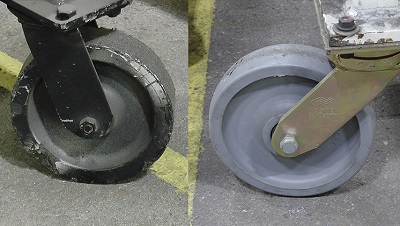Other Voices: The four ways companies are failing to improve push/pull
Revisiting outdated push/pull measuring practices is essential to reducing injury risk.
Editor’s note: The following column by Joe Lyden, president of Caster Connection, is part of Modern’s Other Voices column, a series featuring ideas, opinions and insights from end-users, analysts, systems integrators and OEMs. Click here to learn about submitting a column for consideration.
Despite the fact that it’s has been an ergonomic issue for decades, push/pull injuries are still occurring at an alarming rate, with costs associated with back injuries coming in around $50 to $100 billion. These numbers emphasize the need for push/pull improvement within the workplace. The good news for companies is that there are basically four main areas that affect push/pull, and when a company improves these, injury risk will decrease substantially.
Outdated Push/Pull Measuring Procedures
In order to asses risk, you begin by measuring the force required to move a cart. The most common way to measure push/pull in industry is to use a hand-held force gauge. However, it is very common and easy to get different testing results based off of speed, acceleration, and other factors.
Moreover, many people do not even use guidelines that allow them to remain consistent. Currently, ISO 1228-2 is the most known set of guidelines when someone actually follows guidelines. However, within the last few months, the Ohio State University Spine Research Institute (OSU SRI) completed a study funded, in part, by the National Science Foundation. This study, not yet published academically, recommends a much faster pace (1 m in 3 seconds, 0.5 m/s sustained) for push/pull measuring because this pace more closely approximates the movements performed by real people in industry. What this study shows in general is that virtually everyone in industry has been measuring push/pull force in a way that is detached from injury risk.
Outdated Push/Pull Guidelines
So, how much weight or force is appropriate for a given person? For years, people used the Snook Tables to asses injury risk. However, these guidelines are based on research that is psychophysical (based on test subject opinion). This approach is flawed and less reliable than the current guidelines, provided by the OSU SRI.
These new guidelines are based off of biomechanical testing in which subjects are hooked up to measurement gauges that show graphically how much pressure is placed upon the spine of the subject. In this way, we can see the exact amount of force that puts a subject in danger. Establishing averages, we can extract a much more accurate set of guidelines for the general population. The Spine Research Institute has placed these guidelines online for all to use.
Lack of General Knowledge of How Back Injuries Occur
Within industry, the philosophy is often, “If it ain’t broke, don’t fix it.” The problem with this, in general, is that your back most often does not give you noticeable warning signs that it is being injured. Back injury is normally a cumulative process that can happen over many years. It is not a single moment but rather a long sequence of overexertion that continuously weakens and injures our back. It is only when the disk begins to push against sensitive tissues that we realize our backs are seriously injured. When we are aware of the dangers and nature of back injury, we can take appropriate measures to protect our back.
Poor Ergonomic Equipment
Plain and simple, upgrading your equipment can have huge benefits to push/pull on every level. There are three main pieces of equipment that you can upgrade to prevent injuries.
The first is your cart, particularly the handle placement. Make sure your handle is at the appropriate height for the weight you’re pushing. If you have a cart that has poor handle placement, you can improve push/pull by changing this.
The second is a caster wheel. Casters have direct contact with the floor, and differences between wheels are massive. You can reduce push/pull by 50% to 100%, in some cases, simply by replacing your wheels. The wheel durometer (hardness), size, resilience (bounce), and design will all contribute to the effectiveness of the wheel in reducing push/pull.
The third factor, a caster rig, holds the caster wheel, which spins inside of the rig, and, depending on the style, rotates 360 degrees on a bearing. The quality of the bearings and the design of the rig can make a significant difference in how much force you must exert to get the cart moving, particularly if the wheels are turned on a 90-degree angle.
If you improve these four areas within your facility, you will greatly reduce the risk of injury to anyone involved in push/pull. So, not only will your employees be protected from injury, they will be able to work more efficiently and be happier in general. This all translates into huge monetary benefits as well and allows your business to be more successful on many levels.













